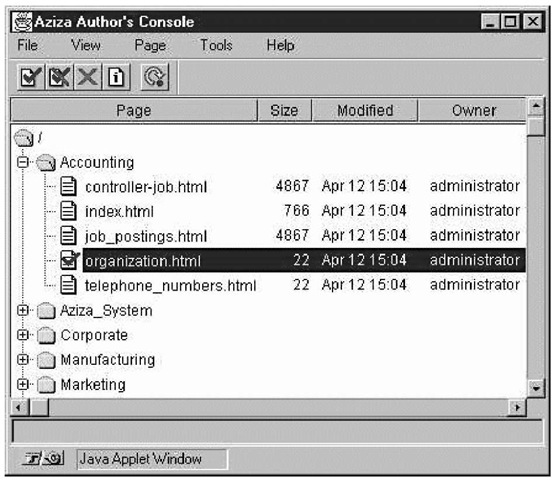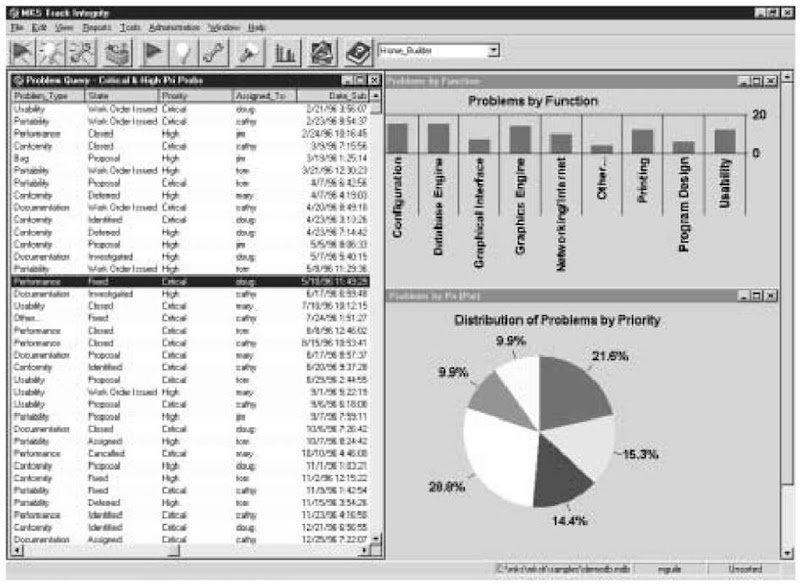A workflow process provides an efficient assembly-line approach to compound document processing whereby operators at each stage develop or revise a portion of the information contained in the document before passing it on. Special workflow management software controls the movement of documents from station to station, typically eliminating redundant tasks and potential confusion concerning which version of a particular document is the most recent. Administrators typically assign new work to available individuals and monitor the quality of work. Workflow management tools are useful in a variety of document processing applications, including insurance claim processing and mortgage loan applications. Such tools are also useful in coordinating the development and maintenance of corporate Web sites.
Today’s Web sites can be comprised of a virtually unlimited number of individual pages scattered across hundreds of servers. Each page may have its own set of links to more pages, applications, or databases. In addition to text, each of these pages can contain active image maps, animated graphics, imaged documents, Java applets, ActiveX controls, audio and video clips, and other objects. Because each of these components may require different skills and expertise to develop, many people can be involved in maintaining the content of a Web site. On large distributed Web sites, this greatly complicates the task of content management.
In these types of environments, special workflow management tools are required to aid content revisions, enforce quality standards, maintain a consistent look and feel, and speed production. With such tools, managers can keep track of the work being performed by all staff members and outside contractors to increase efficiency and eliminate redundancy.
Graphical Management Tools
Two representative products amply illustrate the capabilities of today’s graphical workflow management tools: Aziza’s Enterprise Web Manager and MKS’s Web Integrity.
AZIZA’S ENTERPRISE WEB MANAGER Aziza’s Enterprise Web Manager decentralizes content authorship and centralizes management, allowing one or more administrators to manage multiserver sites.
The Aziza Enterprise Web Manager consists of three software components: a Web Object Manager, two content servers, and three management clients that complement a corporation’s existing infrastructure of Web servers, browsers, page editors, and firewalls.
The first component, Web Object Manager, is the repository for both Web content and Web metadata. Web content can include text, images, applications, and other documents in their native form. Metadata includes title, author, version history, and creation, modification, and expiration dates.
Embedded in the Web Object Manager is the Verity search engine. Az-iza uses Verity to index not only HTML but also native documents such as Lotus 123, Microsoft Word, Microsoft PowerPoint, and Adobe PDF. Verity can search not only full-text content, but also all page metadata including page name, author name, page size, and creation, modification, and expiration dates. These metadata are available for all page types, not just HTML.
The Web Object Manager also guarantees link integrity. Page checkout and check-in facilities guarantee that no other author can simultaneously edit the same page. The check-out operation serves to warn other potential authors that the page is under edit by someone else. If the page is available, an author can edit the content with any file-based editor such as Claris HomePage, Microsoft FrontPage, or Netscape Composer.
When pages change, Aziza does more than simply alert the user to bad links; it prevents them. As destination pages move, the links follow or are reassigned upon page deletion.
Uniform security is also provided by Web Object Manager, even across multiple platforms. Aziza authenticates users on the basis of username, password, and domain name or IP address. Wildcards are supported in both domain name and IP address. User authentication content can be loaded in batch from user and group files. Authentication data is replicated across all Aziza Enterprise Web Managers.
The second component, Content Servers, deliver Web content to browsers and editors, and accept new and edited content. For the HTTP protocol, Aziza supports Netscape’s FastTrack and Enterprise Web. For the FTP protocol, Aziza provides its own server.
The third component, the Management Clients, provides access to authors via a Java applet, administrators via a Windows NT application, and browsers via Javascript and HTML forms.
For authoring, Aziza does not require software to be installed on client machines. Any user can access all content managed by Aziza with an ordinary browser. Because the Aziza Author’s Console (Figure 144) is implemented as a Java applet, no software needs to be installed on client platforms for authoring purposes. The applet is simply retrieved from the server when needed.
With Aziza’s drag-and-drop Administrator’s Console (Figure 145), a Web administrator can distribute or replicate content across multiple Web servers, whether on a LAN or across the WAN. In implementing load balancing, Aziza ensures that replicated content is always identical across servers. Aziza plugs into each server, allowing any administrator or user to access content across all servers. Each Web server functions as a gateway to the content on all Aziza servers—disentangling logical and physical views. A page is identified by the same URL, regardless of the machine that serves up the page.
Multiple administrators can manage the same site. Administrator operations are defined in a way that ensures that no two administrators can interfere with each other’s operations, but which gives both full access to all contents of the Web site.
Figure 144
Azizas Java applet Authors Console.
Figure 145
Aziza’s drag-and-drop Administrator’s Console.
Aziza offers an extensive reporting mechanism. In the Administrator’s Console, administrators can access the properties of users, groups, pages, folders, projects, servers, clusters and other objects. These properties include access controls, version histories, replication status, page attributes, etc.
The same metadata are available through a series of a dozen reports accessible by reference to designated URLs. When one of these URLs is accessed, Aziza delivers the corresponding report for the object (e.g., the page) specified as an argument. These individual reports may be linked together into custom reports as frames in an encompassing page. Access to reports can be limited by setting access controls on specific URLs. Fi-nallyy SQL tools can be used to access all the metadata.
WEB INTEGRITY Web Integrity from Mortice Kern Systems Inc. (MKS) allows developers to access their Web sites by using a Web browser or Sidecar, MKS’s graphical client-side product. MKS’s Web Integrity is a distributed management solution for changing and maintaining Web content. Using Web Integrity, a developer can:
■ Freely make changes to a Web site without any assistance from the Webmaster or team leader
■ Re-create past documents with complete accuracy
■ Safely record new versions of documents for later use
■ Easily view a document’s full history
■ See an audit trail of changes within a document: who, what, and when
■ Lock documents for editing, stopping one author from overwriting another
Web Integrity consists of two software components: the Integrity Engine, a server-side product, and Sidecar, a Java client-side interface. The Integrity Engine functions as an executable common gateway interface (CGI), and works with either Netscape’s FastTrack and Enterprise servers as well as Microsoft’s Internet Information server. Sidecar’s Java interface is geared to the nontechnical corporate knowledge worker. In addition to Sidecar, power users can work with a command-line interface through the browser to connect to a project through the Integrity Engine.
The head revision of the page would appear with a lock on it so others will not be able to make changes on it at the same time. The extra extensions on the URL are Web Integrity’s version control syntax. This allows the developer to make changes on the site from anywhere, provided a Web browser is available.
Sidecar offers a much simpler method of communicating with the Web Integrity Engine. Users do not have to remember URL extensions and can revise files using a preferred HTML editor. Sidecar also allows the entire history of an individual page or graphic file to be viewed. The file can be retrieved and locked for editing, then previewed on a browser, uploaded to the Web server, and viewed remotely from the browser to ensure it is correct. The file can then be unlocked so others can work on it.
Web Integrity saves only the files users explicitly check out, saving space for important changes, not simple changes that do not affect the page design or layout. The entire history of the file can be viewed in the browser by clicking on the Changes button of Sidecar. The developer can view or download any previous version, making the re-creation of the site a very simple matter of uploading the file and saving it as the current version.
With Web Integrity’s Visual Difference utility, developers can compare text-based files individually, side by side, or in a merged view. And with Track Integrity (Figure 146), managers can view problems by their type, state, priority, who they are assigned to, and the date/time they were submitted. Problem types can be grouped by function for comparison in a bar chart, and problems by priority can be compared in a pie chart.
Figure 146
MKSs Track Integrity utility for Web Integrity.
Editing, approving, and publishing Web content one file at a time has been a tedious and frustrating experience for many managers and developers. Web Integrity includes a feature that eases the content approval and publishing process. Web Lens allows corporate users to group a set of Web files together to travel simultaneously through the automated approval and publishing process. For example, a corporate communications specialist can now submit an entire online newsletter, with all its associated HTML, graphics, and Java files, to a VP for final approval.
Last Word
While useful for any document processing application that involves multiple steps, workflow management tools are ideally suited to enhancing the efficiency of Web site development and maintenance. Many corporate Web sites beginning to grow into large, complex databases that are hard to control. While it is easy to add servers and storage to support ever-larger page counts, the long-term concern is how to update and maintain the integrity of all that data. As data amasses and old pages go unchecked, links tend to break down, making the site difficult to navigate and causing users to lose confidence in the validity of the information.
Manual procedures for grooming the data are not sufficient. Consequently, a new generation of tools has become available that manage workflow and automate many database maintenance chores. Their graphical user interfaces make it easy to catalog the pages and links, add content, reassign links, and manipulate entire collections of Web documents that may be distributed among multiple servers. These tools will become even more important as organizations come to rely on their intranets and extranets for mission-critical applications.



